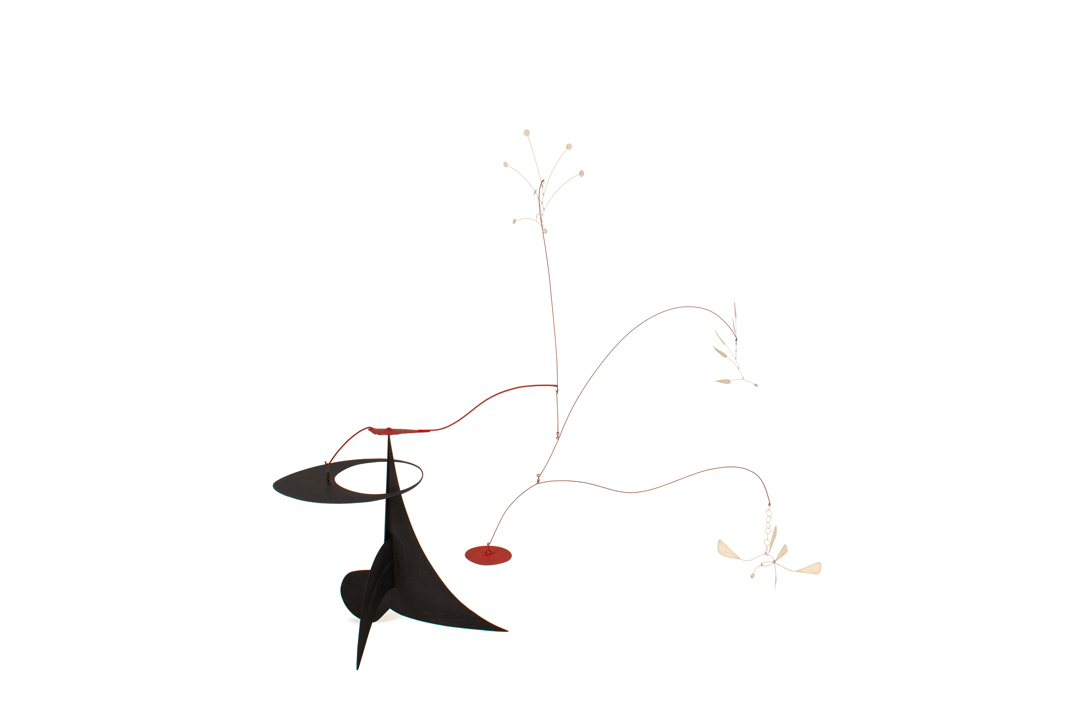A Monumental Gift Goes On View: Inside Calder: In Motion at SAM

“How can art be realized? Out of volumes, motion, spaces bounded by the great space, the universe.”
– Alexander Calder
This November, SAM begins a long-term commitment to Alexander Calder, the American artist celebrated for revolutionizing sculpture with his renowned mobiles and stabiles. Earlier this year, SAM announced the incredible gift of more than 45 seminal Calder artworks by longtime supporters Jon and Kim Shirley. Their magnificent collection—one of the most important private holdings of Calder’s art—is the result of 35 years of thoughtful collecting.
Now on view at SAM, Calder: In Motion, The Shirley Family Collection thematically highlights pieces from every decade of Calder’s career, dating from the 1920s to the 1970s. The exhibition also includes examples of Calder’s works on paper and an oil painting, among other media, representing the expansiveness of his oeuvre. Sections devoted to his artistic experimentation, natural forces and dynamics, and the artist’s lasting contribution to modern art are also featured.
“As truly serious art must follow the greater laws, and not only appearances, I try to put all the elements in motion in my mobile sculptures. It is a matter of harmonizing these movements, thus arriving at a new possibility of beauty.”
– Alexander Calder
To accentuate the artist’s exploration of height, scale, and movement, the exhibition is installed in the museum’s double-height galleries—a unique space for large-scale works with several overlooks from the floor above. The exhibition design captures a sense of movement, with an S-shaped, curved wall that wraps around the iconic 22-foot-tall sculpture Red Curly Tail (1970) and divides the galleries into a series of vignettes illuminating the exhibition’s themes and highlighting the lyricism of Calder’s creations.
Elsewhere on view are the oil painting The Yellow Disc (1958), a medium that Calder engaged with throughout his career but is not nearly as well known as his sculpture; Untitled (Métaboles) (1969), a mobile the artist created as part of a stage set for a ballet; and Fish (1942). The latter, a significant work from a rare series of mobiles created during and after World War II when metal was scarce, is made of wire framing and found materials.
The central gallery traces Calder’s career, highlighting his achievements across the miniature and the monumental. The expansive Toile d’araignée (1965), an airy, monochromatic mobile hovers over several artworks, including the masterful standing mobile Bougainvillier (1947).
“That others grasp what I have in mind seems unessential, at least as long as they have something else in theirs.”
– Alexander Calder
The final gallery considers the artist’s legacy, with works that demonstrate Calder’s accomplishments throughout his most productive decades and his impact on the evolution of modern art. It includes Untitled (1936), Little Yellow Panel (ca. 1936), Jonah and the Whale (ca. 1940), Untitled (ca. 1942), Constellation with Red Knife (1943), Yellow Stalk with Stone (1953), and Squarish (1970). This gallery also serves as a bridge into the museum’s modern and contemporary galleries.
The Shirley family’s generous gift will also inspire public programs exploring Calder’s artistic practice. Events are planned for both the Seattle Art Museum and the Olympic Sculpture Park and will include talks, tours, performances, art-making workshops, and a family-friendly festival—stay tuned for more details!
– Rachel Eggers, SAM Associate Director of Public Relations
This article first appeared in the October 2023 through January 2024 edition of SAM Magazine and has been edited for our online readers. Become a SAM member today to receive our quarterly magazine delivered directly to your mailbox and other exclusive member perks!
Image: Bougainvillier, 1947, Alexander Calder, 1898-1976, sheet metal, rod, wire, lead, and paint, 78 x 82 x 54 in., Promised gift of Jon and Mary Shirley, © 2023 Calder Foundation, New York / Artists Rights Society (ARS), New York, photo: Nicholas Shirley.